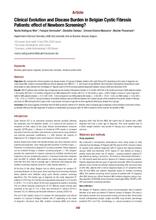Objectives: We compared the clinical evolution and disease burden of 3 groups of Belgian children with cystic fibrosis (CF) depending on the mode of diagnosis: meconium ileus (MI), newborn screening (NBS) and clinical diagnosis (non-NBS) at 1-, 2- and 6 years of age.Methods: We conducted a retrospective observational cohort study based on data collected from the Belgian CF Registry report of 2016 including patients diagnosed between January 2006 and December 2016.
Results: 306 CF patients were enrolled. Age at diagnosis was the lowest in MI patients (median 0.12 months, IQR 0.00-0.36 months) but lower in NBS patients (median 1.38 months, IQR 0.82-1.74 months) compared to non-NBS patients (8.01 months, IQR 2.47-37.58 months, p-value < 0.001). Height z-scores at 1 year of age were better in NBS patients (median = -0.13, IQR -0.99 – 0.50) compared to non-NBS patients (MI median = -0.56, IQR = -01.53 – 0.02, non-NBS median = -0.54, IQR = -1.02 – 0.12, p = 0.03377). Annual prevalence of bacterial infections was not different between the 3 patient groups at the predefined time points. Burden of therapy was lower for NBS during the first 2 years of life. Lung function at 6 years of age did not show significant differences between the 3 groups.
Conclusion: This study suggests a beneficial trend for NBS as primary method of CF detection when comparing age at diagnosis, clinical evolution and burden of therapy between NBS and clinically diagnosed CF patients. A standardized care program after CF-NBS is needed.



